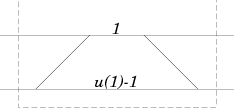A Bilinear Form for the DFT
A bilinear form for a prime length DFT can be obtained by
making minor changes to a bilinear form for circular convolution.
This relies on Rader's
observation that a prime p point DFT can
be computed by computing a p–1 point circular convolution
and by performing some extra additions 2.
It turns out that when the Winograd or the split nesting
convolution algorithm is used, only two extra additions
are required.
After briefly reviewing Rader's conversion of a prime length
DFT in to a circular convolution,
we will discuss a bilinear form for the DFT.
To explain Rader's conversion of a prime p point DFT
into a p–1 point circular convolution 1 we
recall the definition of the DFT
with
W
=
exp
–
j
2
π
/
p
.
Also recall that a primitive root of
p
is an integer
r
such that
 maps the integers
m
=
0
,
⋯
,
p
–
2
to the integers
1
,
⋯
,
p
–
1
.
Letting
n
=
r
–
m
and
k
=
rl,
where
r
–
m
is the
inverse of
rm
modulo
p
,
the DFT becomes
maps the integers
m
=
0
,
⋯
,
p
–
2
to the integers
1
,
⋯
,
p
–
1
.
Letting
n
=
r
–
m
and
k
=
rl,
where
r
–
m
is the
inverse of
rm
modulo
p
,
the DFT becomes
for l=0,⋯,p–2.
The `DC' term fis given by
 By defining new functions
By defining new functions
which are simply permuted versions of the original sequences,
the DFT becomes
for l=0,⋯,p–2.
This equation describes circular convolution and therefore
any circular convolution algorithm can be used to compute
a prime length DFT.
It is only necessary to
(i) permute the input, the roots of unity
and the output,
(ii) add x(0) to each term in Equation 4.4
and
(iii) compute the DC term.
To describe a bilinear form for the DFT we first define a
permutation matrix Q for the permutation above.
If p is a prime and r is a primitive root of p, then
let Qr be the permutation matrix defined by
for 0≤k≤p–2 where ek is the kth standard basis vector.
Let the  be a p–1 point vector of the roots of unity:
be a p–1 point vector of the roots of unity:
If s is the inverse of r modulo p (that is, rs=1 modulo p)
and  , then
the circular convolution of Equation 4.4 can be computed with the
bilinear form of ???:
, then
the circular convolution of Equation 4.4 can be computed with the
bilinear form of ???:
This bilinear form does not compute y(0), the DC term.
Furthermore, it is still necessary to add the x(0) term
to each of the elements of Equation 4.7 to
obtain y(1),⋯,y(p–1).
Calculation of the DC term
The computation of y(0) turns out to be very simple when the bilinear form
Equation 4.7 is used to compute the circular convolution in Equation 4.4.
The first element of  in Equation 4.7 is the residue modulo
the polynomial s–1, that is, the first element of this vector is the
sum of the elements of
in Equation 4.7 is the residue modulo
the polynomial s–1, that is, the first element of this vector is the
sum of the elements of  .
(The first row of the matrix, R, representing the reduction operation
is a row of 1's, and the matrices P and Qr are permutation matrices.)
Therefore, the DC term can be computed by adding the first element of
.
(The first row of the matrix, R, representing the reduction operation
is a row of 1's, and the matrices P and Qr are permutation matrices.)
Therefore, the DC term can be computed by adding the first element of  to x(0).
Hence, when the Winograd or split nesting algorithm is used to perform the
circular convolution of Equation 4.7, the computation of the DC term
requires only one extra complex addition for complex data.
to x(0).
Hence, when the Winograd or split nesting algorithm is used to perform the
circular convolution of Equation 4.7, the computation of the DC term
requires only one extra complex addition for complex data.
The addition x(0) to each of the elements of Equation 4.7
also requires only one complex addition.
By adding x(0) to the first element of
 in Equation 4.7
and applying QstJPtRt to the result, x(0) is added to each element.
(Again, this is because the first column of Rt is a column of 1's,
and the matrices Qst, J and Pt are permutation matrices.)
in Equation 4.7
and applying QstJPtRt to the result, x(0) is added to each element.
(Again, this is because the first column of Rt is a column of 1's,
and the matrices Qst, J and Pt are permutation matrices.)
Although the DFT can be computed by making these two extra additions,
this organization of additions does not yield a bilinear form.
However, by making a minor modification, a bilinear form can be retrieved.
The method described above can be illustrated in Figure 4.1 with  .
.
Clearly, the structure highlighted in the dashed box can be
replaced by the structure in Figure 4.2.
By substituting the second structure for the first, a bilinear
form is obtained.
The resulting bilinear form for a prime length DFT is
where  ,
x=(x(0),⋯,x(p–1))t,
and where Up is the matrix with the form
,
x=(x(0),⋯,x(p–1))t,
and where Up is the matrix with the form
and Vp is the matrix with the form

























